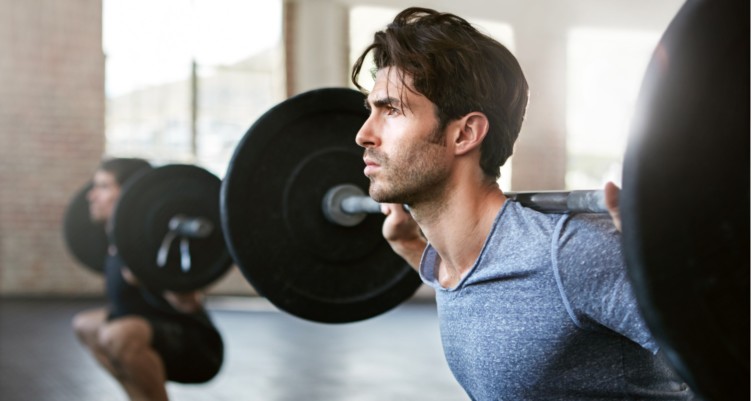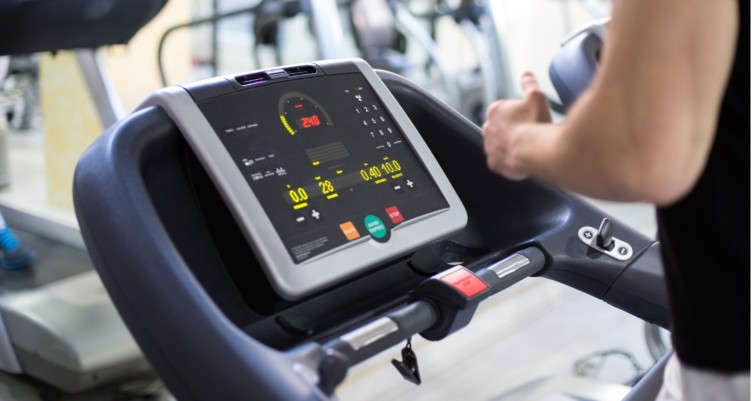Cardio vs. Strength Training: Is One Better than the Other?

- Although cardio vs strength training remains a highly debated subject in the fitness community, both forms of exercise bring unique physical and mental health benefits.
- If you’re wondering if you should focus on cardio or weights, that depends largely on your personal wellness goals. These may include everything from building lean muscle to reducing stress to boosting your self-confidence.
- The most effective fitness plan doesn’t focus solely on strength or cardio. Our comprehensive guide explains why you should incorporate both forms of exercise into your life.
There are two sides to every coin. And in the case of exercise, that couldn’t be more true. Yet, when the topic of cardio vs strength training comes up in conversation, it seems like most people believe you’re either in one corner or the other.
But, are there actual benefits to lifting weights over rowing? Or does it make more sense to put down the kettlebell, lace up your running shoes and hit the track?
That all depends on what you want to achieve. We all have different health and wellness goals, so choosing between cardio or weights boils down to the individual. However, the reality of working out is that you don’t necessarily have to ditch one form of exercise for the other.
Our below guide provides all the information you need on the benefits of both forms of calorie burning, including how the two exercise formats can work harmoniously to help you achieve your goals.
Do I need to choose between cardio vs strength training?

You walk into your local gym and see an empty treadmill and an open squat rack. Which one should you choose?
Answering that is impossible without first knowing what you want to accomplish. Do you want to increase your lean muscle mass? Are you focused on burning the most calories possible during that session? Or, do you have performance-based goals you want to achieve?
For some, loading up a barbell and pumping out reps (with good form, of course) aligns with a personal fitness mission. For others, stretching out the legs and opening up the lungs makes more sense based on specific health goals.
So is strength training better than cardio? Or, is it the other way around?
The short answer is, both forms of exercise have science-backed benefits. Instead of worrying about cardio vs weights results, follow a well-rounded fitness routine that allows you to work toward achieving your goals in a safe, enjoyable manner.
Like keto and intermittent fasting, think of these practices as a complementary wellness duo.
Now, let’s take a deeper dive into how both training styles can benefit various wellness goals.
Goal 1: To burn calories

Benefits of cardio: If burning calories matters most during your workout, you can’t go wrong with cardio. A recent Harvard study showed a 185-pound person burned 126 calories doing 30 minutes of general weight training. However, low-impact aerobics (231 calories), moderate rowing (294 calories) and even walking/jogging (252 calories) proved far better as calorie-burning activities.[1] On a per-session basis, cardio is king when it comes to burning calories.
Benefits of strength: While a weight-training workout won’t burn more calories than a cardio workout of the same duration, that doesn’t mean lifting isn’t worth your time. Since muscle is more metabolically active than other tissues, it burns more calories at rest.[2] Increasing your amount of lean muscle tissue via strength training will boost your metabolism and calorie-burning ability.
Goal 2: To build muscle
Benefits of cardio: Aerobic exercise generally gets a bad rap in relation to building muscle. Viewed as a catabolic activity (breaking down compounds and body tissues), it doesn’t seem like the ideal way to increase lean muscle mass. However, a 2015 study put a slight damper on that argument by showing aerobic exercise can produce skeletal muscle hypertrophy.[3]
Benefits of strength: Even if you don’t want bulging biceps or shredded abs, it’s still important to focus on building muscle. And, it shouldn’t be a surprise that lifting weights will get you on the right path to achieve this goal faster than cardio. As shown by a 2019 study, a higher volume of resistance training enhances muscle hypertrophy. You simply can’t beat a well-designed strength training program when it comes to building muscle.[4]
Goal 3: To combat stress
Benefits of cardio: Does a runner’s high actually exist? If you’re out of shape, you may not feel too chipper about going for a jog. However, science does support the idea of cardio being a positive form of stress relief. Aerobic activity results in elevated serotonin levels in the brain. Since this neurotransmitter helps improve symptoms of depression and anxiety, it’s safe to say cardio should be viewed as a beneficial way to combat stress via exercise.[5]
Benefits of strength: Had a stressful day at work? Try picking up a set of free weights. When life seems overwhelming, consider strength training as a solution. Resistance training helps your brain produce more endorphins, which can bring about feelings of pleasure and happiness.[6] So when stress is getting to you, don’t let that negativity drag you down. Instead, get your motivational playlist going, hop on the bench press and start pumping some iron.
Related: How to Sleep Better and Manage Stress with Exercise
Goal 4: To increase athletic performance

Benefits of cardio: If you play a sport, you shouldn’t need an introduction to the benefits of cardio. Getting your heart and lungs healthy and operating at full capacity will help you perform better on the field, court or wherever your athletic endeavor takes place. If you build up your aerobic capacity, you stand a much better chance of performing well from the first whistle to the last. Plus, you can work on elements like speed and agility via cardio-based activities like sprinting, ladder workouts and footwork drills.
Benefits of strength: Even in sports that don’t necessarily seem power-oriented, strength still matters. After all, no matter if you’re a figure skater, baseball player or swimmer, a strong core and well-developed stabilizer muscles will go a long way in helping you succeed. And, for those who participate in sports that require explosive movement (like rugby, football, basketball and mixed martial arts), traditional strength-based exercises like squats and deadlifts provide a tremendous bang for your buck since they require full-body activation.
Pro tip: For easy access to sustained energy and a dose of quality fats, drink a Bulletproof Coffee before you head to the gym to fuel your training goals.
Goal 5: To boost your confidence
Benefits of cardio: Need a little pick-me-up? Going for a long bike ride could do the trick. In addition to the rush of hormones (hello, endorphins!) you get from a cardio workout, you can boost your confidence further by challenging yourself to accomplish performance-related goals. When you set small milestones (such as trimming a minute off your mile run) and achieve them, you will feel rewarded for your efforts. You might even get motivated to compete in a race, which can also lead to a boost in self-confidence, especially if you cross the finish line first!
Benefits of strength: Most of us probably have an image planted in our minds of what our ideal body looks like. Unfortunately, life’s stressors can throw us off track and cause frustration and self-doubt. Strength training can be a great way to get your confidence levels right. Besides feeling a sense of accomplishment after finishing a tough set or setting a new personal record, you should feel good looking at yourself in the mirror after a moderate-to-intense workout. As sweat drips and your muscles swell, you can breathe a sigh of relief (when you have the chance) about whatever’s been bothering you. Instead, focus on the fact that you’re making your body and mind better with every rep.
Related: A Guide on How to Think Positive—and Why It Matters
Benefits of combining cardio with strength training

Clearly, working out isn’t a one-size-fits-all approach. And in the case of lifting vs cardio, it makes more sense to combine both methods of training, rather than choose one over the other.
But, why’s that the case?
On one hand, if you integrate cardio and strength into a single workout, you will cut down on how much time you have to spend in the gym. Making your routine more efficient will allow you to get more done and still reap the rewards of both forms of physical activity.
From a health-benefitting perspective, it pays off to do both, too. If you focus solely on cardio, you could end up losing lean muscle. On the flip side, if you only focus on strength, you won’t burn as many calories per workout, and you may put too much stress on your tendons, ligaments and joints over time.
The combination of both cardio and strength training gives you the chance to:
- Increase your metabolism by building lean muscle.
- Improve your heart and lung health via aerobic activities.
- Boost your confidence and mental well-being through the release of hormones like serotonin.
Scheduling workouts: cardio vs. strength training

There’s no doubt that cardio and strength training belong together. But, how exactly should you set up your schedule to accommodate both methods of physical fitness?
Again, there isn’t a foolproof template to follow. However, there are a few different ways to structure your workout schedule to include cardio and strength:
- Keep them separate: One method is to switch between cardio- and strength-focused workouts. This strategy allows you to tackle one challenge at a time, so you won’t get overwhelmed by having to push your lungs and heart hard on the same day you have to get under a barbell. Try having an A/B day setup where you alternate between cardio and strength. (Just remember to take a rest day!)
- Cardio first, weights after: If your primary goal doesn’t involve building muscle, consider jumping into your cardio first. You can get in a solid 20-30 minute workout on an elliptical machine or treadmill that will test your aerobic (and mental) capacity before wrapping up with a low-intensity, high-rep strength session to burn extra calories and give your muscles a different challenge.
- Start with strength, finish with cardio: Care more about strength, size and power? Then, schedule your workouts to start with weight training. You don’t want to drain your glycogen stores or fatigue your muscles by doing cardio and then try to get through a difficult strength-training routine. Instead, get your lifts in and finish with a low-impact form of cardio that won’t cause too much stress on your joints.
The bottom line: Don’t spend too much time choosing between cardio or weights. The best way to take care of your body and brain is to incorporate both forms of exercise into your fitness routine. Not only do certain goals align better with a particular type of activity, but blending cardio and strength training together will keep you on your toes and challenge you to push yourself in multiple ways. The key: Find a happy medium!
Mapping out a new fitness plan often goes hand in hand with cleaning up your diet. Learn how limiting sugar intake can positively impact your health and weight goals.
Sign up for early access to sales, product launches, the latest Bulletproof news and more!



